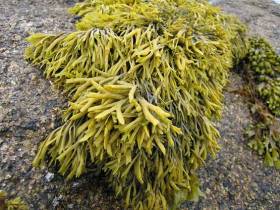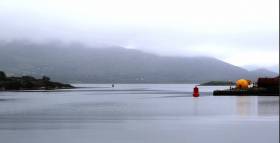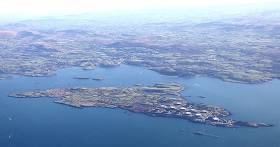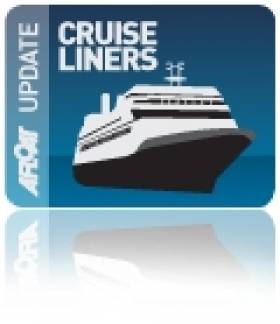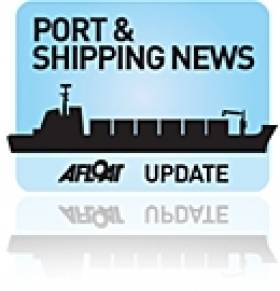Displaying items by tag: Bantry Bay
#Tallships - A pair of ships, one a Danish trainee tallship, the other a former Norwegian 'Hurtigruten' coastal passenger/cargoship but trading now as a cruiseship, are anchored closely to each other off Bantry, Co. Cork today, writes Jehan Ashmore.
The tallship is Danmark, which provides 80 trainees to learn sailing skills from MARTEC- the maritime and polytechnic college based in the Nordic country's cityport of Frederikshavn.
For the past 75 years, Danmark has been the principal training ship for the state of Denmark. From 2003, the operation of the trainee ship transferred to MARTEC, however the vessel still remains as state property. A major refit of the berth decks took place just over a decade ago, this led to an upgrade of the teaching facilities and the installation of air-conditioning.
The other Bantry Bay anchored ship, Serenissima, is a small luxury expedition cruiseship that once plied on the famous Norwegian 'Hurtigruten' coastal fjords voyage when named the Harald Jarl.
Since 2003, the role of the the ship changed having been sold to become the 59 cabin capacity cruiseship Andrea but now trades as Serenissima for Noble Caledonia. They deployed the 160 passenger cruiseship to Irish ports among them Dun Laoghaire Harbour where a call was made last season.
Serenissima had called to the same berth where the Frederikshavn registered Stena Carrier in recent weeks occupied the Carlisle Pier. The pier provided the venue last Sunday for the Red Bull Flug-Tag event that saw handmade aircraft attempted to take off!
The Danmark's trainee season schedule for 2018 is currently operating Voyage no. 105. According to MARTEC, trainees began attending the maritime sea-craft skills school in January, and by March the ship departed the waters of Scandinavia bound for Cadiz, Spain.
The tallship's last port of call was Ponta Delgada. This is the capital on São Miguel Island, part of the Azores archipelago of Portugal.
Danmark was commissioned by the ship's namesake government in 1932 at the Nakskov Shipyard in Lolland and was fitted out as a three mast full-rig ship. The decision of this rig was seen as the most complex and therefore demanding to keep most hands busy when the ship entered service the following year.
For many years, all officer apprentices from major Danish shipping companies joined a mandatory training voyage.
In 1939, Danmark visited the United States to participate in the World’s Fair held in New York City. The outbreak of hostilities of WWII however on the other side of the Altantic, forced the ship to stay in US waters to avoid the Germans capturing the vessel.
During the war, Danmark was based in Jacksonville, Florida. It was after the attack on Pearl Harbor, that the captain offered the ship to the U.S. government for the continued purposes as a training vessel. The offer was accepted which led to the ship spending the rest of the war by training cadets at the United States Coast Guard Academy.
This role in the USCG would remain until 1946 when the Danmark was returned unharmed, resulting in resuming training duties for the Scandinavian state.
Port Company Welcomes First Liner to Bantry In 30 Years
#BantryBay - MS Prinsendam of Holland America Line made her maiden call to Bantry Bay Harbour writes West Cork Times on what was to be the first visit of a cruise liner to Bantry in almost 30 years.
Carrying more than 800 passengers, MS Prinsendam arrived in the early hours of the morning and will stay until evening ensuring their passengers get every opportunity to explore the region.
Speaking about the arrival of MS Prinsendam to Bantry, Bantry Bay Port Company Harbour Master Captain Paul O’Regan said, “We are very encouraged by Holland American Lines commitment to call to Bantry. This is an exciting time for the whole of West Cork as we aim to grow this cruise business considerably over the next few years.
“We have the experience and professionalism within the Port of Cork of what needs to be achieved to grow the cruise business here, and Bantry Bay Port Company is fully committed. The unique selling point with Bantry is to attract the smaller boutique cruises or expedition cruises which can access smaller ports and harbour, meaning their passengers can benefit from a richer experience onshore.”
For more on this story click here.
Bantry Bay Residents Speak Out Over Seaweed Harvesting Licence
#CoastalNotes - While Bantry Bay prepares to open up as a maritime hub for Ireland’s South West, local coastal residents are expressing concern over the first State licence for the mechanical harvesting of seaweed.
As the Irish Examiner reports, Kerry-based BioAtlantis secured the licence after a five-year application process — but now faces growing opposition from local communities, many of which have hand-harvested seaweed for hundreds of years, who claim lack of consultation over the plans.
Pantry resident Deirdre Fitzgerald said the issue only came to wider public attention earlier this year, when an episode of RTÉ One’s Eco Eye detailed the planned harvest of nearly 2,000 acres of kelp forest.
“We have white tailed eagles resident in the bay, whales, dolphins, seals, otters, and so many bird species that rely on this bay for food,” she told the Irish Examiner. “What will be the impact on juvenile fish as a food source for all these species once this kelp is removed from the bay?”
However, BioAtlantis chief executive John T O’Sullivan said “everything was done by the book” in relation to its application process. The Irish Examiner has much more on this story HERE.
In other coastal news, objectors to Galway Bay’s marine energy test site have questioned the legality of the foreshore lease application, pointing out that a number of key documents were not included, according to the Connacht Tribune.
The same newspaper also reports on claims of “outrageous” public expenditure on the now-shelved Galway Bay fish farm project, a controversial scheme that cost the State more than half a million euro.
Opening Up Bantry Bay – A Maritime Hub In the South West
Bantry Bay is one of this island’s greatest maritime resources and is about to be opened up with a new marina very close to the centre of the town. Twenty-two miles long from its entrance and with 22 slipways and launching areas, plus a couple of islands, this can be a cruising mecca.
The Port of Cork Company which took over Bantry Harbour from the previous local harbour authority, has spent €9.5m. on the development of facilities there, turning the old pier area into a more extensive commercial facility, improving depth of access and providing in the inner harbour, a new marina. The development will operate under the aegis of the Bantry Bay Port Company.
All of this promises a new future for the harbour and Bantry as a maritime hub, not only for the leisure sailor, but for angling, fishing, other maritime activities and attracting more cruise ship visits by the improve facilities. The marina will provide 30/40 berths dependent upon size of vessel, dredged to a depth of 4 metres.
On this week’s THIS ISLAND NATION PODCAST, Cork and Bantry Harbour Master, Captain Paul O’Regan, outlines the development to me. I started by observing that nine-and-a-half million Euros was a big financial commitment to Bantry.
New Navigation Buoy Installed at Lawrence Cove, Bantry
New navigation buoys have been installed at the entrance to Lawrence Cove, near the village of Rerrin on Bere Island, one of the most sheltered harbours in Bantry Bay on Ireland's South–West coast.
A marina at Lawrence Cove is located opposite the fishing port of Castletownberehaven at the North side of Bere Island. Lawrence Cove Marina is the only fully serviced marina between Kinsale and Cahirciveen making it an important stop–over location for cruising yachts.
Bantry Bay Port Launches Primary Schools Initiative
Bantry Bay Port Company has launched its first Schools Initiative for 2016 aimed at 5th class primary schools.
The initiative theme ‘A Day in the Life of a Cruise Passenger Visiting Bantry Harbour’ is aimed at encouraging school children to explore the tourism aspect of Bantry harbour and all the wonderful visitor attractions to see and enjoy in the West Cork region.
Tourism plays a vital role in Bantry Bay Port Company’s business with a number of small cruise liners visiting the harbour each year. These cruise passengers and crew visit West Cork during the summer months, bringing a welcome economic tourism contribution to the region.
All 5th classes who participate in the Bantry Bay Port Company’s initiative will be invited on a boat trip around beautiful Garnish Island, compliments of Bantry Bay Port Company. An award will also be given for ‘Best Artwork Piece’ and each participating class and teacher will receive a Class Certificate of Participation.
Captain Paul O’Regan, Bantry Bay Port Company Harbour Master said: “We are excited to be launching our Bantry Bay Port Company Schools Initiative. The initiative is a great way for primary school children to learn about the history of Bantry port and the role it plays in the region. The theme this year relates to cruise tourism and this is an area Bantry Bay Port Company will be aiming to increase in the coming years.’
He continued: ‘Many local families are involved in tourism either directly or indirectly and so it’s important that children understand tourism and the business it generates for the region. We hope our initiative will make learning fun for the school children.’
Projects must contain a high level of visual content and can contain photographs as well as artwork. The creativity of each project will be taken into account when being judged as well as visual impact, originality, content and presentation. Bantry Bay Port Company will provide each participating school with a piece of ply-wood 2ft x 2ft and this must be used for the project. Closing date for submissions is Friday 6th May 2016. All submitted projects will go on public display in Bantry during the summer months.
To register your primary school or for further information, please visit the Bantry Bay Port Company website
€11m Tonnes of Trade in 2015 By Port of Cork & Bantry Bay Port
Total traffic through the Port of Cork and Bantry Bay Port Company in 2015 reached a total of 11 million tonnes. Total Trade traffic at the Port of Cork reached 9.8 million tonnes up a significant 10% on 2014 traffic figures. Bantry Bay Port Company dropped slightly from 1.3 million tonnes in 2014 to 1.1 million tonnes in 2015. These figures are extremely positive for the port and show trade is beginning to return to pre-recession times.
Total container volumes through both Tivoli and Ringaskiddy Container Terminals in the Port of Cork grew by 8% compared to 2014 figures with over 205,000 TEU’s handled. This is very encouraging particularly as the Port received planning permission to move all container operations to Ringaskiddy in the near future. Dry bulk cargos such as animal feed, increased by 2% in 2015 while fertilisers and cereals both decreased slightly.
Liquid bulk cargo, predominantly the oil traffic through Whitegate Oil Refinery, currently owned and operated by Phillips 66, continues to have a significant impact on the overall traffic through the Port of Cork with oil traffic in 2015 showing an increase of almost 20%. This significant increase in 2015 is attributed to an increase in demand from the domestic market as recovery takes hold and due to maintenance shut-down in the Whitegate refinery in 2014 which affected refining for a six week period. Traffic from the Bantry Bay Oil Storage Terminal is operated by Zenith Energy, which accounts for 100% of the commercial traffic through Bantry Bay Port.
Commenting on the 2015 trade traffic results, Port of Cork Chairman Mr. John Mullins said: ‘We are pleased with the total trade traffic figures across both Bantry and Cork in 2015. Achieving traffic figures which are in line with pre-recessionary time highlights the beginning of the positivity returning to the market and I am confident that we can sustain this growth across 2016. Container traffic increased by 8% indicating the confidence in the consumer market for imports and the growth of exports in the agricultural and pharmaceutical sectors. The Port’s move to Ringaskiddy is vitally important to meet expected further growth in this market.’
He continued “Whitegate oil Refinery operated by Phillips 66 is a key customer within the port and we are extremely encouraged to see oil traffic up compared to 2014. Phillips 66 currently has the refinery on the market for sale and we would remain hopeful that it would be sold as an operating refinery.”
The Port of Cork cruise business grows year on year with 55 scheduled cruise liners calling to Cork in 2015. In total these liners carried in excess of 145,000 passengers and crew to the region. These transit visitors are an excellent economic stimulus for Cork, bringing a welcome boost to the local economy for eight months of the year. The Port of Cork has completed work on upgrading the facilities at Cobh Cruise Terminal and can now handle ‘Quantum Class’ vessels, which are the largest liners operating in Europe today. The Port of Cork continues to work closely with cruise lines to increase calls to both Port of Cork and Bantry Bay.
Brittany Ferries had another very positive year with their seasonal service from Cork to Roscoff carrying 84,378 passengers in 2015. This figure is up compared with 2014 and it is hoped that 2016 will be another busy year for Brittany Ferries when sailings resume.
In 2015 the Port of Cork was granted planning permission for the Ringaskiddy Port Redevelopment which is a milestone for the Port of Cork and particularly the Munster region. According to Chairman Mr. Mullins, receiving planning permission for the Ringaskiddy Port Redevelopment has given the organisation a renewed confidence in the future of trade for the Cork region. He said; ‘Not only is this a great boost for our company but most importantly for our customers, who can now confidently plan for the future, knowing the port has the capacity to accommodate their growth.’
Following a public tender process in November, advance works on the project are due to begin in January 2016. These advance works are a positive step in terms of the Ringaskiddy port redevelopment and will include site clearance to the proposed container compound area which will serve to prepare the site to ensure the main works are not delayed. The next step is to launch the main works tender process in April 2016, with a view to contract being awarded in Q3 2016. It is estimated that 849 FTE jobs will be created during the construction of the Ringaskiddy Redevelopment Project which the Port aims to have operating by Q4 2018.
The Port of Cork is committed to seeking out new business opportunities for the Port and in particular, the agri-food business will be a key sector which the Port of Cork is keen to develop. Other areas include the offshore oil exploration field and of course establishing new trade links from Cork.
The Port of Cork Schools Initiative is now in its eleventh year and aims to educate 5th class primary school children about the rich history associated with Cork Harbour and to highlight the importance of having a local port to facilitate the connectivity to world markets. The initiative also gives children a better understanding of where cargo comes from and how Ireland, as an island depends on Ports for trading. This year’s theme (2016) ‘A Day in the Life of a Cruise Passenger Visiting Cork’ focuses on the leisure and tourism aspect of the harbour, county and city and encourages school children to see what their region has to offer international visitors.
The Port of Cork’s recreational strategy continues to expand with the aim of improving the marine leisure facilities around Cork Harbour and the Port of Cork continues to be an ongoing supporter many of the local harbour festivals and events, local sporting clubs in the harbour and cultural events in the city.
#BantryBay - Sea Explorer I entered the scenic seclusion of Glengariff in Bantry Bay today and where the mere 90m vessel of 4,200 tonnes anchored off Garnish Island, writes Jehan Ashmore.
The 114 guest luxury small ship, part of the cruise agency operator Noble Caledonia fleet is according to Bantry Bay Port Company schedule to be the only caller so far listed for 2015.
Accommodation of the 1991 Italian built vessel is of 57 spacious suites and all outside with an average of 245 sq ft. Facilities offered are of a high standard albeit on board an intimate sized ship.
Yesterday she had been to St. Peter Port, Guernsey again at an anchorage along with Cunard Line's 90,080 tonnes Queen Victoria. The Cunarder had departed Southampton at the weekend to mark the start of the company's 175th anniversary with a celebratory cruise in company down Solent water.
Tomorrow she calls to Cobh on the centenary of the RMS Lusitania disaster during WW1.
Last month the Port of Cork outlined plans for Phase 1 of the Bantry Inner Harbour Development (incl 20-berth marina) which will be undertaken on behalf of its subsidiary company, Bantry Bay Port Company.
Over two years ago Sea Explorer (see photo) arrived to Dun Laoghaire Harbour albeit in a 'lay-up' mode in advance to taking up a European season with cruises starting in June 2013.
She is equipped with Zodiacs for expedition landings and for reaching isolated locations.
Another expedition / polar cruiseship Fram with 400 passengers and operated by Norwegia based Hurtigruten was understood to be the first caller to Galway Harbour this season.
The call of the Fram took place at the end of April and likewise of the 'Explorer' this involved anchoring offshore.
Containership Under Overnight Repairs in Bantry Bay
#ShipRepairs – Atlantic Companion, a massive containership which had experienced engine problems according to The Irish Examiner, was understood to have undergone continued repairs last night in the shelter of Bantry Bay.
The 57,000 tonnes vessel lost engine power and drifting for almost 12 hours off Cork on Tuesday.
The Swedish-flagged vessel was en-route from Liverpool to Halifax when it experienced problems with one of the six cylinders on its main engine.
However Gerry Callanan of ACL, the container shipping company which owns the vessel, told customers who have containers on board that he expects the vessel to resume its trans-Atlantic voyage at some stage tomorrow (this Thursday) morning.
For more on the story, click HERE.
The Sailing & Boating Wonders of Ireland's West Cork Coast
The sailing paradise of West Cork on Ireland's south-west coast is at its best right now, and the south coast fleets are already heading that way for the traditional West Cork regattas in August. WM Nixon reflects on the magic sailing region of West Cork.
West Cork is as much of a frame of mind as a specific place. Officially, we might suppose it to extend all the way along the Rebel County's coast from the Old Head of Kinsale to Dursey Island away in the far nor'west, up at the north side of the wide entrance to Bantry Bay. But this doesn't necessarily mean that all the folk in the hinterland north of this coastline see themselves as being in West Cork.
As for boat people, our limits are much more narrowly defined. If you're afloat down there, West Cork is that sublime but compact bit of coastline between Galley Head and Mizen Head, just 38 miles as the gannet flies. It's the ultimate lotus land, with an interesting scattering of islands, blessed moreover with an abundance of sheltered natural harbours each with its own port town or village vying with its neighbours in colourful character. And visible from much of it is the Fastnet Rock, mysteriously a place of the remotest ocean despite being only a matter of four miles from the nearest land at Cape Clear.
In this magic land, the local mini-capital is of course Skibbereen, the very essence of a rural market town. But on the coast, the very different harbours of Schull, Baltimore, and sometimes even Glandore have been seen over the years as the sailors' capital of West Cork. Recently, however, it is Baltimore which has gone from strength to strength to affirm its position as the sailing capital of the southwest, and spending a June night there as summer settled comfortably over Munster reinforced the impression of its pre-eminence.
We were on a bit of a land cruise, so the bed for the night was in the Waterfront, the hotel where Room 12 is just about as near to the beating heart of Baltimore as you can get. Aboard a cruiser in Baltimore, you can enjoy that splendid isolation which a boat so easily confers. But in Room 12 on top of the Waterfront's northwest corner above the square, the busy life of the little port town bubbles about you, and the views across to Sherkin Island and over the country to Mount Gabriel get even more perfect with the approach of sunset.
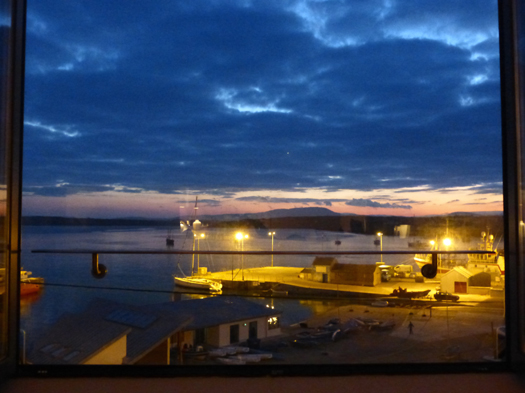
The view from Room 12 at the Waterfront in Baltimore. The sun has set beyond Mount Gabriel, but somebody is busy launching a newly-arrived RIB by floodlight, and the buzz from the square below is still rising. Photo: W M Nixon
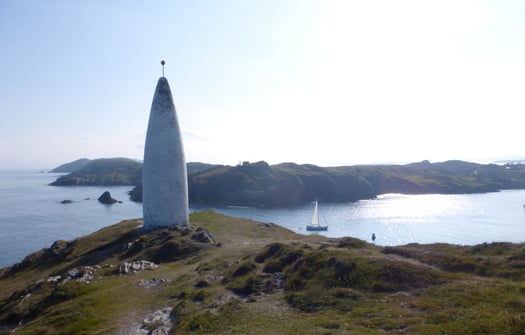
It has to be one of the best arrivals in world sailing. A cruiser enters Baltimore beneath the Baltimore Beacon, aka Lot's Wife. Photo: W M Nixon
It was fifty years ago when I first sailed in to Baltimore, coming in from the west on a round Ireland cruise, and entering port close under the beacon – Lot's Wife they call it – to find a quiet little place which showed some signs of a former prosperity, and hinted at better times to come. Back in 1964, it still had its railway station, but the West Cork Line was in its final year and was soon to be totally closed. Before that happened, later that summer when Baltimore Sailing Club hosted Dinghy Week for the Irish Dinghy Racing Association, the Firefly Class in Dun Laoghaire – mostly university boats – had been able to have a Tuesday night race. Then they'd towed their boats into Dun Laoghaire station on the launching trolleys, put them onto a CIE flat truck, and found them on Friday night safely delivered by rail the entire way to West Cork, offloaded ready at the harbourside station in Baltimore, and waiting for the arrival of thirsty crews keen for a bit of sport.
Mostly, they'd got themselves there by overloading some little car belonging to somebody or other's mother, so the fact that they disdained to use the railway themselves would help to explain why such a charming amenity was doomed. Since then, of course, Baltimore Railway Station from 1969 until recently had become Ireland's first Glenans base. But life moves on, the Glenans model doesn't seem to work any more in Ireland, so now the former station is for sale by the powers-that-be, and there are ructions being raised about it all which should keep everybody nicely exercised through the rest of the summer.
It was another French import which currently sets the pace in Baltimore. Around 1980 a young Breton fisherman, Youen Jacob, came into the harbour, and in time he settled there. To say that Youen Jacob has played a major role in Baltimore life is understating the case. It is he and his family who have developed the Waterfront – quite a challenge in somewhere as conservative as West Cork – and with Youen Jnr's Jolie Brise restaurant and guest house beside it to provide an alternative aspect of good Breton cuisine, the Jacob family's establishments have given a healthy new configuration to Baltimore's miniature harbourside square, and have settled in so well you could be forgiven for thinking the little town was built around them.
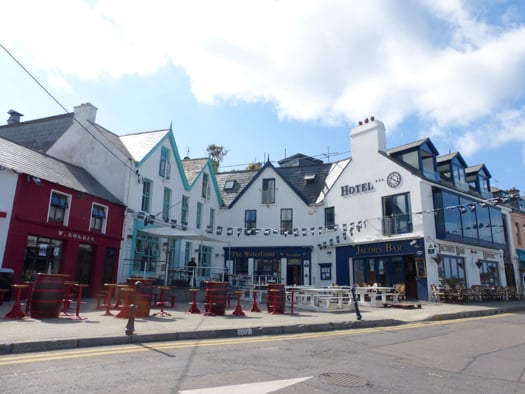
The Waterfront (right) and Jolie Brise at the south side of the mini-square in Baltimore bring a welcome breath of Brittany to West Cork. Photo: W M Nixon
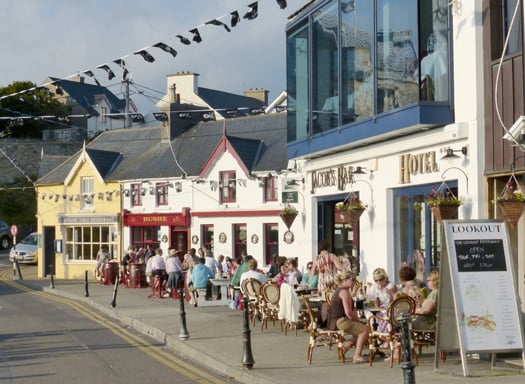
It's party time in Baltimore. The al fresco lifestyle is expected in West Cork in summer. Photo: W M Nixon
There are times when you'd understandably think this is the hub of the maritime universe, and why not? But if, during a quiet cruise, you think you might find it too hectic at night when the joint really is jumping, the sensible thing is to call by at lunchtime when everybody is out at the islands and Baltimore is refreshed and catching its breath for the next night's partying. Then in the evening, you can pop over to Sherkin Island where peace will reign while Baltimore ramps up the socializing.
Up in our eyrie above the square, we savoured the life of this busy little port. It's not quite a 24-hour town, but late at night boats were still being launched by floodlight, and conviviality continued in the square. Finally, peace descended, and though most folk were slow to stir early in the morning, the first ferries were coming in, and a workboat headed out for the islands, going past Graham Bailey's Peel Castle, the remarkable bisquine-rigged variation on a 50ft 1929-built Cornish lugger which is seen at her best on her mooring in Baltimore harbour. This is only right and proper, as the restoration and re-configuration of Peel Castle took place nearby, just up the Ilen River at one of the boatyards at Oldcourt.
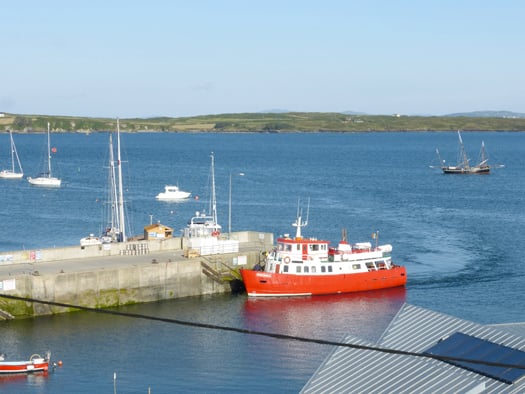
Good morning Baltimore, how are you? The first ferry arrives in from Sherkin Island. Photo: W M Nixon
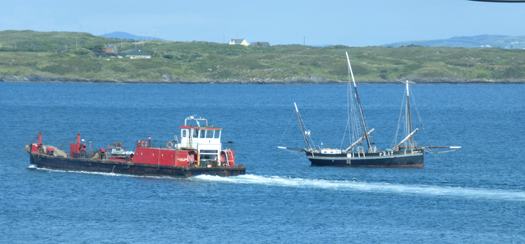
Getting the day's job started. A workboat heads out towards Sherkin past Graham Bailey's distinctive Peel Castle. Photo: W M Nixon

Peel Castle in all her glory in the middle of Baltimore Harbour. Restoring this 1929-built 50ft Cornish fishing boat and giving her a bisquine rig took Graham Bailey eight years of dedicated work at Oldcourt. Photo: W M Nixon
Another Baltimore revival which gets our approval is the restoration of the castle right in the middle of town, the "tigh mor" which presumably gives the place its name. We suffer from a widespread ruins overload in Ireland, so it's refreshing to find that somebody upped and took action, brining a ruin back to life and giving Baltimore a very effective signature focal point with a useful function. You could do the same to good effect at Dromineer on Lough Derg, where the ruined castle is an eyesore.
But you don't even have to leave the Baltimore area for a worthwhile restoration project, as just across the harbour beside the pier on Sherkin is the roofless ruin of the 15th Century Franciscan friary which we know looks much better with its roof back on, even if it has been missing since the 1770s.
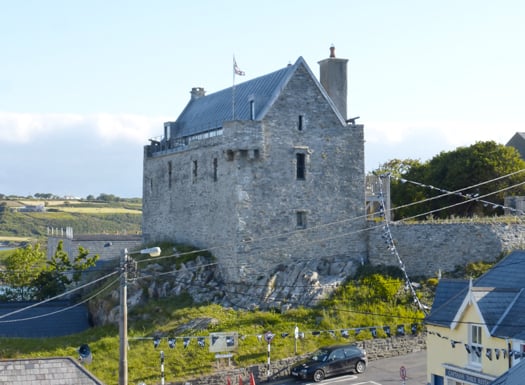
The restoration of the castle at Baltimore has given welcome and useful new life to a former ruin. Photo: W M Nixon
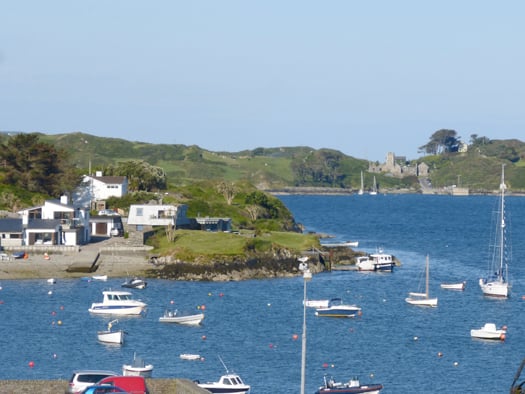
The Cove on the south side of Baltimore Harbour has some very desirable real estate. Photo: W M Nixon
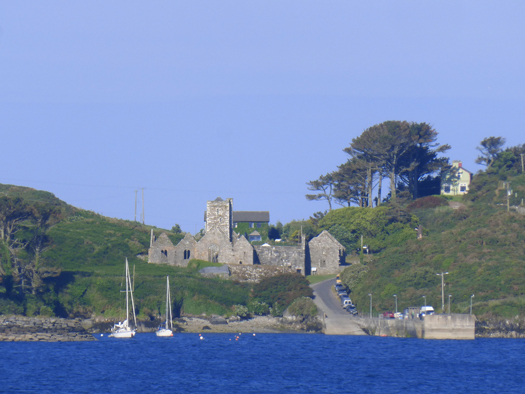
Thanks to its use as a film set in 1973, we know that the friary on Skerkin Island looks much better with it roof in place. Photo: W M Nixon
We know this because, in 1973, the makers of a TV film managed to get permission from the OPW to put a temporary but very convincing roof in place, and it looked so utterly right. The film was the unfairly forgotten Catholics, based on the novel of the same name by Belfast-born Brian Moore, and memorably starring Trevor Howard as the troubled Father Abbot. Even in this usually overlong blog, there isn't space to go into the details of the story, but it's worth viewing Catholics at the very least to see how well Sherkin friary looks with a roof. Alas, when filming was done the production company religiously (how else?) adhered to the OPW's demands to return the very attractive little old building to its ruinous state, and there it sadly sits.
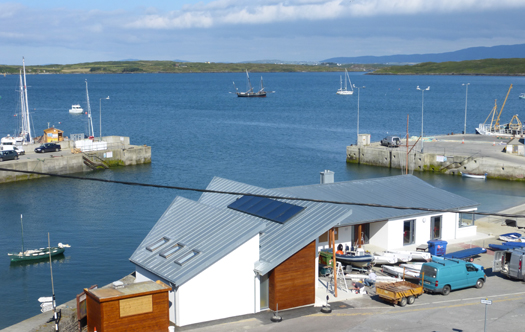
This year's work on Baltimore Sailing Club has made it even more of a local asset. Photo: W M Nixon
But as regular readers of Afloat.ie will know, other refurbishment and extension work has been under way in Baltimore, with the Sailing Club in fine fettle in its extended premises which look so well you'd think it's all new. It's certainly all of a piece with Baltimore's vitality, which contrasts with other little West Cork ports. In Baltimore, the key to it all is the fact that the Waterfront gallantly stays open all year round. But at present in Schull and Glandore, the main hotels don't even open in summer.
Doubtless in time, and sooner rather than later, both establishments will be brought back to life. But for people genuinely cruising, the absence of a hotel or two doesn't matter that much in an area where the abundance of cruising options and hospitable pubs with good food is almost bewildering. And around Baltimore in particular, there's always something going on.
The wholesome 1893-built cutter Eva (later known as Guillemot) was restored at Oldcourt, which is only a few miles from her birthplace 121 years ago on the Baltimore waterfront. Brian Marten's project to have Eva re-born and continue as Guillemot has come to a successful conclusion after she went through several vicissitudes before he happened upon her, but a visit to Oldcourt will reveal many other boat restoration, re-build and re-birth projects at various stages, including some which - as our accountancy friends would insist on putting it - are no longer going forward.
Be warned, however, that any visit to Oldcourt in any capacity whatever is likely to take longer than you expect, as there's simply so much to see. And they're at every stage, from projects just starting, through projects stalled, to projects nearing completion, while inspiration was being provided by a visiting boat, Darryl Hughes' immaculately-restored 1937 43ft Tyrrell ketch Maybird, which was berthed for a while at Oldcourt to let boatbuilder John Hegarty take off measurements in order to build a traditional clinker dinghy which will fit on board.
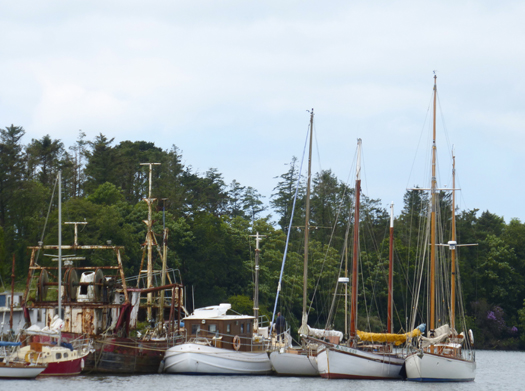
Boats in a row at Oldcourt. The further from the quay, the more ready for sea you are. Furthest out is the 1937 Tyrrell ketch Maybird, with which owner Darryl Hughes regularly attends the annual Yeats Summer School in Sligo. He's the only participant to arrive by sea, and he lives on board at the pontoon in Sligo during the Yeats festival. Photo: W M Nixon
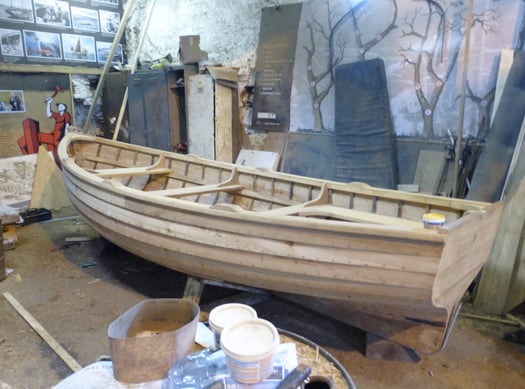
A new traditional clinker dinghy, built by John Hegarty of Oldcourt, awaits her first coast of varnish. Photo: W M Nixon
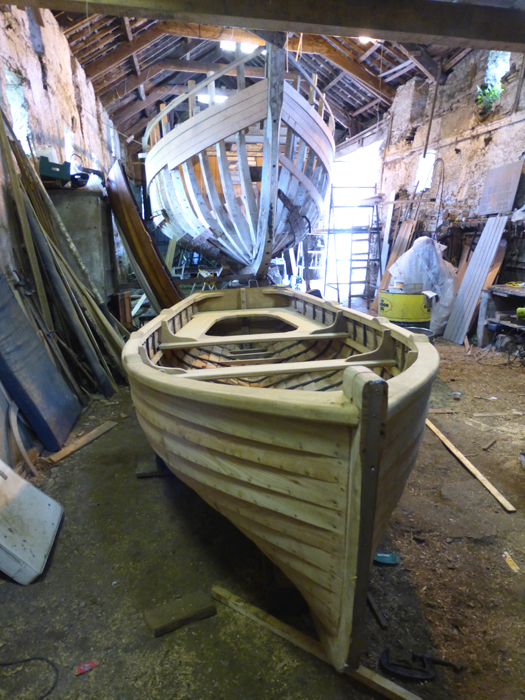
The new dinghy shares space with Conor O'Brien's Ilen, which continues to be a major work in progress. Photo: W M Nixon
Just to show what the result will be like, there was another recently-completed Hegarty dinghy in the Ilen shed, and very well it looked too. As for the restoration of Conor O'Brien's Ilen herself, that can best be described as ongoing. It has become such an absorbing task that the restoration process might best be thought of as an end in itself. Trying to work out what could most usefully be done with this hefty big lump of a boat if she ever is restored to seagoing condition is something which will require many brainstorming sessions, but it surely doesn't need to be considered in too much detail just yet.
The problem with the Ilen is she's too small for some things, and too big for others. She's of the same sort of in-between size which made the first Asgard of limited use as an official sail training vessel. Asgard was fine for teaching young people to sail, but she was simply too small to keep up with the tall ships which also completely overshadowed her in port, where Ireland's little ketch also failed to provide the necessary space and impressive setting for entertaining local bigwigs.
Manageability is the keynote to successful boat restorations. But Oldcourt is such a maritime universe that it can provide examples of what you'd think might have been eminently manageable restoration projects, yet they've ground to a halt. One such is Englyn, the creme de la crème of the boats amateur-designed by Harrison Butler, the English opthalmologist. In the 1930s, he was designing boats which successfully anticipated the highly-regarded designs of Lyle Hess more than forty years later, and the 26ft 6ins Englyn was so highly thought of by cruising guru Eric Hiscock that he included the design in his seminal book Cruising Under Sail, first published 1950.
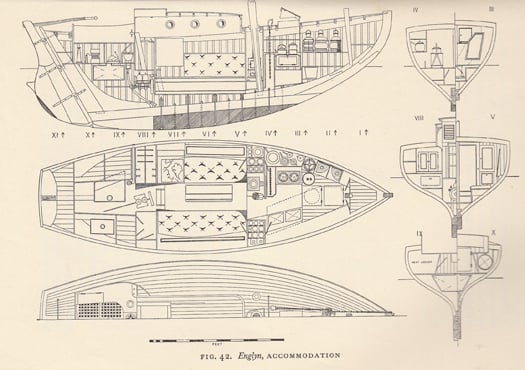
Plans of the Harrison Butler-designed Englyn, as featured in Eric Hiscock's Cruising Under Sail.
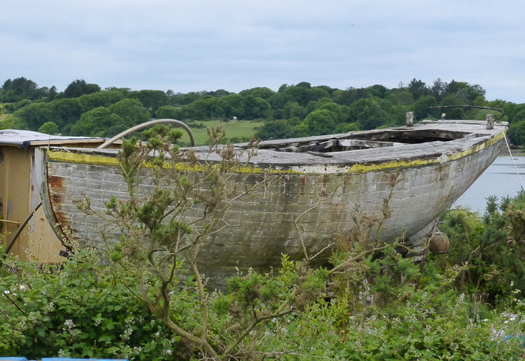
A little boat that may have missed the boat. Englyn as she is today. Photo: W M Nixon
If anything, the designs of Harrison Butler are more cherished than ever, and in this blog on May 10th we featured photos of the Harrison Butler Khamseen class cutter which ace boatbuilder Steve Morris is creating near Kilrush. It's heart-breaking to see the lines of Steve's healthy boat palely reflected in the weather-beaten remains of Englyn as she is today. But sometimes boats really can be brought back from the near-dead, and at the two-day Glandore Classic Boat Summer School in mid-July, the entire Sunday afternoon was given over to presentations about boats in various stages of restoration in and around Oldcourt.
Despite some unpleasantnesses visited upon it by the lingering death of the Celtic Tiger, Glandore gallantly soldiers on. Glandore Harbour Yacht Club's new headquarters in a cleverly rebuilt two-storey cottage up a side street (the only side street, as it happens) is appropriate to the good taste which prevails in this sweet place, whose name in Irish can mean either the golden harbour, or the harbour of the oaks - either will do very nicely.
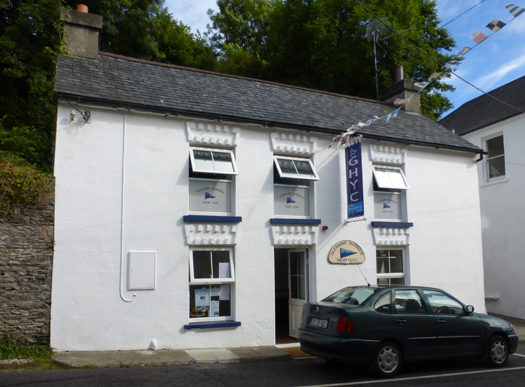
Glandore Harbour YC's clubhouse is now this cleverly re-built two-storey cottage beside the harbour. Photo: W M Nixon

The outboard dinghies waiting at the pontoon at Glandore Pier give a good indication of the number of boats based in Glandore and across the harbour at Union Hall. Photo: W M Nixon
The Summer School packed in an extraordinary variety of topics, and even this blogger was wheeled out to develop his thesis based around the ambiguous question: Why shouldn't the Irish be a seafaring people? Don't worry, for those who missed it, we'll push it out again here some time in the depth of winter. But we cannot hope to convey the full wonder of the best event in the Summer School, the question-and-answer session between ocean voyaging and offshore racing legend Don Street and his son Richard.
The old boy hasn't half been around. And if at some time your only experience of Don Street has been a high-pitched New England rant about some iniquity of modern yachting (fibreglass dismissed as "frozen snot", for instance) it's my happy duty to assure you that, as he delved into his extraordinary memories, the pitch of Don Street's distinctive voice became deeper and more resonant, until by the time he concluded all too early, we could have been listening to Captain Ahab himself.
From such a treasure trove of recollection, there were many gems, perhaps the best being about how he came to make his profession in writing about the sea and sailing. In his early days in the Caribbean before he'd put pen to paper, on one run ashore Don and his shipmates met up with Nobel Laureate John Steinbeck, and they'd a convivial time together. Later, heading back along the islands, they'd another dinner with the great writer, and during yarning at table, Don's shipmates insisted he'd so many good stories to tell that he should write them down.
"But I don't know how to spell, and I know nothing about grammar" complained Don.
"But you've a story to tell" said Steinbeck, "and you tell it well. Just you write it down, and the editors will sort out the spelling and the punctuation and the grammar. That's their job."
God be with the days......
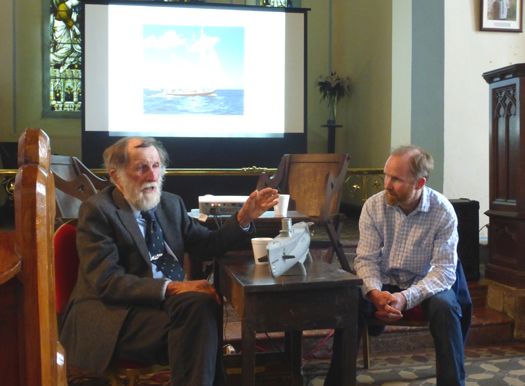
The old man of the sea – Don Street's reminiscences were the highlight of this year's Glandore Classic Boat Summer School. The school sessions were held in the harbourside church, and Don is seen here with his son Richard while he recalls his days in submarines in the US Navy. On the screen is his legendary 1905-built yawl Iolaire, in which he cruised the Caribbean and crossed the Atlantic. Photo: W M Nixon




























